Apple's iPhone: The Future is Here
by Anand Lal Shimpi on July 2, 2007 6:13 PM EST- Posted in
- Smartphones
- Mobile
Using it as a Phone
Early on in what I'll call the camera-phone boom, someone clever came up with the complaint that there are no phones out there that just make phone calls well. They all have poor camera interfaces, are mediocre MP3 players and do a boatload of other things without having actually perfected making phone calls. As infuriating as it may sound, Apple's $500 iPhone actually fills the phone call niche quite well.
The only UI downside to using the iPhone as a phone is that you need to first click on the phone button at the bottom of the screen before you can access its ability to place phone calls. Obviously incoming calls can be received at any point, but if you actually want to dial out you have to hit that little green button first.
The iPhone is the perfect melding of your address book and a mobile phone. You have four options for dialing out on the iPhone, you can dial from a list of your favorite numbers, you can look at your call log, you can dial from your address book or do it the old fashioned way with the keypad.
If you're kickin' it old school, the keypad is absolutely enormous, something you don't find on the vast majority of mobile phones, and a true testament to Apple's idea of a morphing interface. In keypad mode, all you need on the screen is a gigantic keypad, having a virtual interface makes that possible.
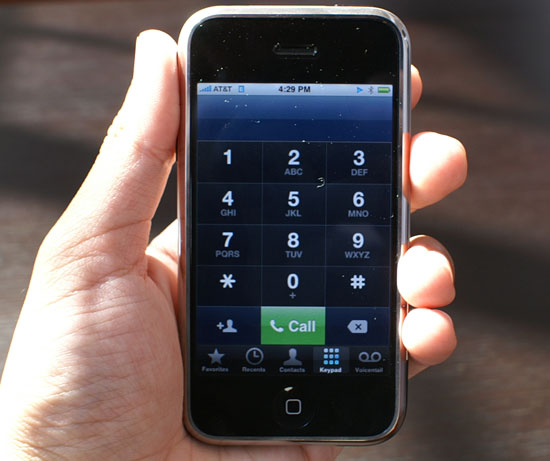
Dialing from your address book is just as simple as playing an MP3 on the iPhone, flick your finger up or down to find the contact, click on it and click on the number you'd like to call (e.g. work, home or mobile). Admittedly the contact list took some getting used to (I'm still not totally comfortable with it) being that the names on the screen are so large compared to what I'm used to on the Blackberry. In a way it seems like I'm lost trying to find the person I'm looking for since I'm so used to using a scroll wheel or trackball to navigate through a huge list of much smaller fonts.
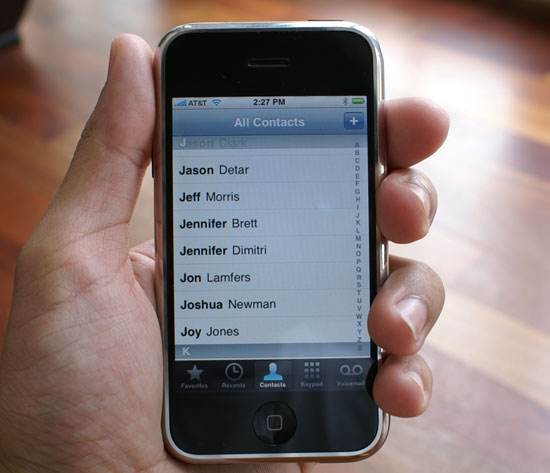
The recents view is your call log; it logs incoming, outgoing and missed calls. Missed calls are colored red, and you can also view them separately by tapping missed at the top of the screen. The interface doesn't distinguish between incoming and outgoing calls until you click the little blue arrow to the right of the call.
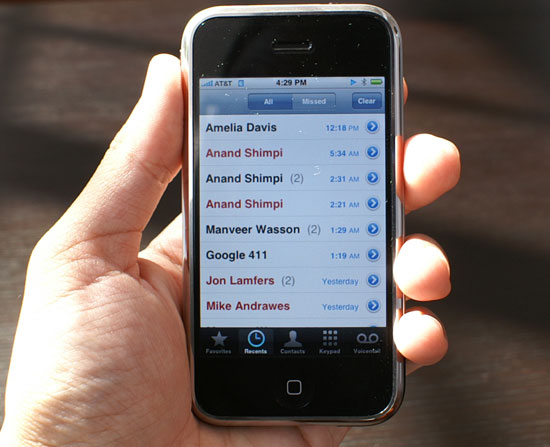
A call log done right
Multiple calls to/from the same person within close proximity in time are grouped together, with the number of calls placed in parentheses. Selecting additional details about any group of calls will tell you exactly when the calls took place. None of this data is unique to the iPhone, the Blackberry and Blackjack both offer it, but neither competitor presents it in such a clean and easily accessible way.
Your favorites are basically your speed dial numbers, for those contacts that you call/harass oh so frequently, it's just one touch to call from this list.
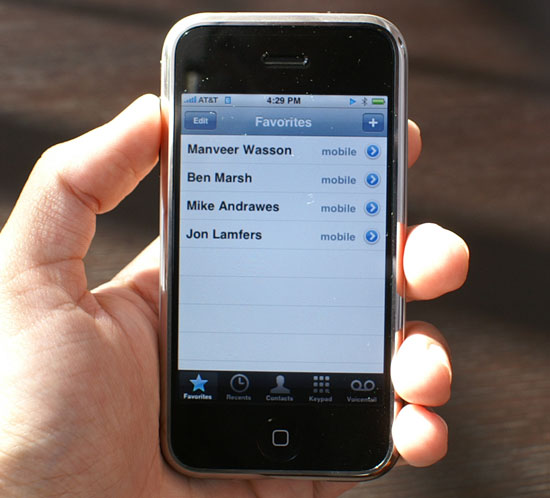
Steve Jobs' visual voicemail demo at Macworld was one of the things that really got me excited about the iPhone, it was voicemail done right. In practice, it works just like you'd expect it to.
When you get a voicemail your iPhone will vibrate and the phone icon at the home screen will get a little 1 next to it, indicating that you have one unchecked message of some sort (either a missed call, or in this case a voicemail).
The voicemail interface is super simple, you're presented with a list of people who have left you messages and you can listen to them in any order. No calling a weird number and dealing with an automated voicemail system; your voicemail is handled the way it is done on any VoIP platform, except this is on your cellphone.
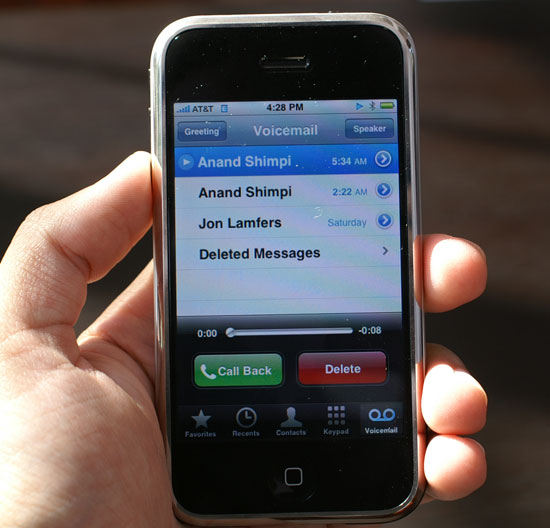
Let's see what Anand left us!
You can even record your voicemail greeting from this interface.
Features like forwarding voicemail simply aren't available from the iPhone and I have no idea how visual voicemail works (or doesn't) if you're roaming on other networks. The iPhone doesn't let you select what GSM/Edge network you're on, so I couldn't force it to join a non AT&T network to see the impact on visual voicemail.
The device isn't ergonomically suited to being held up to your head for prolonged periods of time, if you're going to be having long conversations you'll want to invest in a bluetooth headset. The weight of the device contributes to it being uncomfortable while held up to your ear.
The earpiece gets really warm if you use the WiFi a lot, and putting it up to your ear while on the phone will result in profuse ear-sweats. It's not as hot as the bottom of the MacBook Pro for example; it's warm enough to notice, not to burn.
The speakerphone works well and voice quality is respectable, at least compared to the Blackjack and Blackberry Curve.










85 Comments
View All Comments
rcc - Tuesday, July 3, 2007 - link
If there is no GPS hardware built into a device, 3rd party software won't help. You have to have the hardware receiver built in.
Locutus465 - Wednesday, July 4, 2007 - link
Fortunetly by law every new phone activated as of 2005 must have built in GPS for E-911.. Just one small baby step from there repurposes that GPS for coolness... My i720 allows this.strikeback03 - Thursday, July 5, 2007 - link
Doesn't the law simply require the carrier to be able to determine the location of the phone, but not specify how? Allowing the carriers to determine by distance to cell towers instead of GPS?Locutus465 - Thursday, July 5, 2007 - link
I beleive GPS is required... At least this is what I was told by a Verizon rep that refused to activate an older phone I had.Cygni - Thursday, July 5, 2007 - link
GPS is not required by law, yet. Location support IS required, but is already present on nearly every phone made in the last 3 years.plinden - Tuesday, July 3, 2007 - link
Leo Laporte in one of his podcasts this weekend mentioned that he heard there is an SDK for the iPhone that's ready for OS X but not Windows, but Apple (ie Jobs) wants to release both versions at the same time, hence the delay.
That's just a rumor, but it's almost certain there'll be an SDK at some point, although it's extremely likely, if not certain, that developers will have to go through Apple to get their apps published to the iPhone (ie via iTunes).
Give it six months, like I'm doing. I'll likely get the 16GB version with 3G when it's available.
Locutus465 - Tuesday, July 3, 2007 - link
There will need to be good 3rd party support for me to even consider it. There'll also need to be a good (and inexpensive) all in one chat client. And Mahjoong, that's totally a requirement.sviola - Tuesday, July 3, 2007 - link
You should check the Nokia N95, it has the built-in GPS, altough it runs Symbian OS.Locutus465 - Tuesday, July 3, 2007 - link
Well yes, my phone has built in GPS hardware as well (as do all phone inc. iPhone). It's just missing the app + maps (unless you're sayind the nokia comes with software + maps which would be the bomb). So I would just need that part of the equation. As a matter of fact the Samsung i720 also allows you to use the phone as a plain old GPS device, so really if I wanted to I could potentially blue tooth it to a laptop for instance and go that route.Locutus465 - Tuesday, July 3, 2007 - link
Oh yeah, on the i720 to set an MP3 as your ring tone you just need to browse to it in flie explorer, tap and hold ("right click" in Windows Mobile) and select "Set as ringtone" :)Automatically copies to \Windows\Rings and sets the song as your ringtone :D